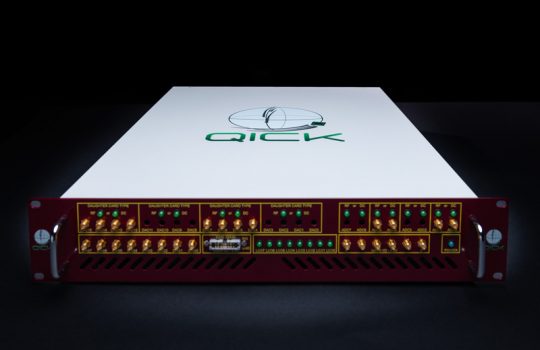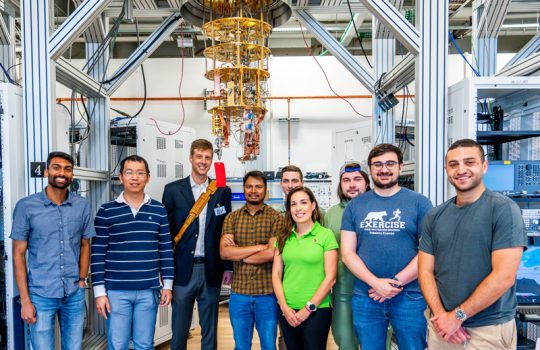The U.S. Department of Energy has awarded researchers at its Fermi National Accelerator Laboratory more than $3.5 million to boost research in the fast-emerging field of Quantum Information Science.
“Few pursuits have the revolutionary potential that quantum science presents,” said Fermilab Chief Research Officer Joe Lykken. “Fermilab’s expertise in quantum physics and cryogenic engineering is world-class, and combined with our experience in conventional computing and networks, we can advance quantum science in directions that not many other places can.”
As part of a number of grants to national laboratories and universities offered through its Quantum Information Science-Enabled Discovery (QuantISED) program, DOE’s recent round of funding to Fermilab covers three initiatives related to quantum science. It also funds Fermilab’s participation in a fourth initiative led by Argonne National Laboratory.

The DOE QuantISED grants will fund initiatives related to quantum computing. These include the simulation of advanced quantum devices that will improve quantum computing simulations and the development of novel electronics to work with large arrays of ultracold qubits.
For a half-century, Fermilab researchers have closely studied the quantum realm and provided the computational and engineering capabilties needed to zoom in on nature at its most fundamental level. The projects announced by the Department of Energy will build on those capabilities, pushing quantum science and technology forward and leading to new discoveries that will enhance our picture of the universe at its smallest scale.
“Fermilab is well-versed in engineering, algorithmic development and recruiting massive computational resources to explore quantum-scale phenomena,” said Fermilab Head of Quantum Science Panagiotis Spentzouris. “Now we’re wrangling those competencies and capabilities to advance quantum science in many areas, and in a way that only a leading physics laboratory could.”
The Fermilab-led initiatives funded through these DOE QuantISED grants are:
Large-scale simulations of quantum systems on high-performance computing with analytics for high-energy physics algorithms
Lead principal investigator: Adam Lyon, Fermilab
The large-scale simulation of quantum computers has plenty in common with simulations in high-energy physics: Both must sweep over a large number of variables. Both organize their inputs and outputs similarly. And in both cases, the simulation has to be analyzed and consolidated into results. Fermilab scientists, in collaboration with scientists at Argonne National Laboratory, will use tools from high-energy physics to produce and analyze simulations using high-performance computers at the Argonne Leadership Computing Facility. Specifically, they will simulate the operation of a qubit device that uses superconducting cavities (which are also used as components in particle accelerators) to maintain quantum information over a relatively long time. Their results will determine the device’s impact on high-energy physics algorithms using an Argonne-developed quantum simulator.
Partner institution: Argonne National Laboratory
Research technology for quantum information systems
Lead principal investigator: Gustavo Cancelo, Fermilab
One of the main challenges in quantum information science is designing an architecture that solves problems of massive interconnection, massive data processing and heat load. The electronics must be able to operate and interface with other electronics operating both at 4 kelvins and at near absolute zero. Fermilab scientists and engineers are designing novel electronic circuits as well as massive control and readout electronics to be compatible with quantum devices, such as sensors and quantum qubits. These circuits will enable many applications in the quantum information science field.
Partner institutions: Argonne National Laboratory, Massachusetts Institute of Technology, University of Chicago
MAGIS-100 – co-led by Stanford University and Fermilab
Lead Fermilab principal investigator: Rob Plunkett
Fermilab will host a new experiment to test quantum mechanics on macroscopic scales of space and time. Scientists on the MAGIS-100 experiment will drop clouds of ultracold atoms down a 100-meter-long vacuum pipe on the Fermilab site, and use a stable laser to create an atom interferometer which will look for dark matter made of ultralightweight particles. They will also advance a technique for gravitational-wave detection at relatively low frequencies.
This is a joint venture under the collaboration leadership of Stanford University Professor Jason Hogan, who is funded by grant GBMF7945 from the Gordon and Betty Moore Foundation. Rob Plunkett of Fermilab serves as the project manager.
Other participating institutions: Northern Illinois University, Northwestern University, Stanford University, Johns Hopkins University, University of Liverpool
Fermilab was also funded to participate in another initiative led by Argonne National Laboratory:
Quantum sensors for widie-band axion dark matter detection
Lead principal investigator: Peter Barry, Argonne
Researchers are searching high and low for dark matter, the mysterious substance that makes up a quarter of our universe. One theory proposes that it could be made of particles called axions, which would signal their presence by converting into particles of light, called photons. Fermilab researchers are part of a team developing specialized detectors that look for photons in the terahertz range — at frequencies just below the infrared. The development of these detectors will widen the range of frequencies where axions may be discovered. To bring the faint signals to the fore, the team is using supersensitive quantum amplifiers.
Other participating institutions: National Institute of Standards and Technology, University of Colorado



